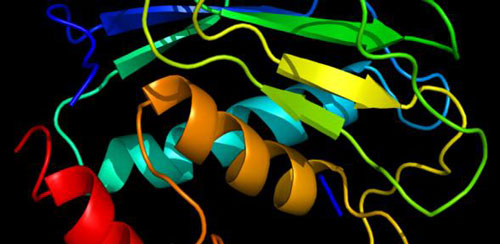| Nov 26, 2015 |
Moonlighting molecules: finding new uses for old enzymes
|
|
(Nanowerk News) Enzymes are biological catalysts – molecules that speed up chemical reactions within living materials. Many enzymes are already well characterised and their functions fairly well understood. For example, the enzyme known as MMP8 is present in the connective tissue of most mammals, where it breaks the chemical bonds found in collagen.
|
|
In pre-clinical research published in the journal Chemistry & Biology ("Combinatorial Screening Identifies Novel Promiscuous Matrix Metalloproteinase Activities that Lead to Inhibition of the Therapeutic Target IL-13"), Dr Florian Hollfelder from the Department of Biochemistry at Cambridge and Dr Lutz Jermutus,Senior Director, Research and Development at MedImmune, led a study to map a list of human enzymes (proteases) against potential protein drug targets.
|
 |
| Structure of the MMP8 protein. Based on PyMOL rendering of PDB 1a85. (Image: : Emw)
|
|
Using automation technology at MedImmune, the team then tested each of the enzymes against each target protein in turn, allowing them to identify a significant number of so-far unknown interactions.
|
|
Of particular interest was how MMP8 was able to disable a molecule known as IL-13, which is known to play an important role in several inflammatory diseases such as asthma and dermatitis. The researchers believe this may be a previously-unknown way in which the body regulates the action of IL-13, preventing these diseases in the majority of individuals. If so, it could provide an interesting target for new drugs against these common diseases.
|
|
“MMP8 is well-known to biochemists and we all thought we understood its function, but it’s clear that this – and probably many other enzymes – ‘moonlight’ and have several functions within the body,” explains Dr Hollfelder. “Because the enzyme already had a ‘name’ and a function, nobody thought to see if it had a promiscuous side.”
|
|
Designing new enzymes has proven an extremely difficult technical challenge, hence the drive to find new uses for previously ‘understood’ enzymes. By focusing on human proteases, rather than bacterial proteases – which are actually easier to source – the researchers are confident that their research will be far more applicable to drug discovery.
|
|
“Our approach is new: we ‘recycle’ known enzymes and ask whether they can do other things than the ones they are known for,” adds Dr Jermutus. “In fact, we believe we have found other enzymes that could be similarly deployed against other disease-causing proteins, and this approach, if expanded, could provide further leads for new drugs.”
|
|
Commenting on the benefits of the collaboration with industry, Dr Hollfelder adds: “Without MedImmune, our work would have stopped after seeing and characterising the interactions. The additional extension to cell and mouse models would have been inconceivable in my basic science group.”
|

